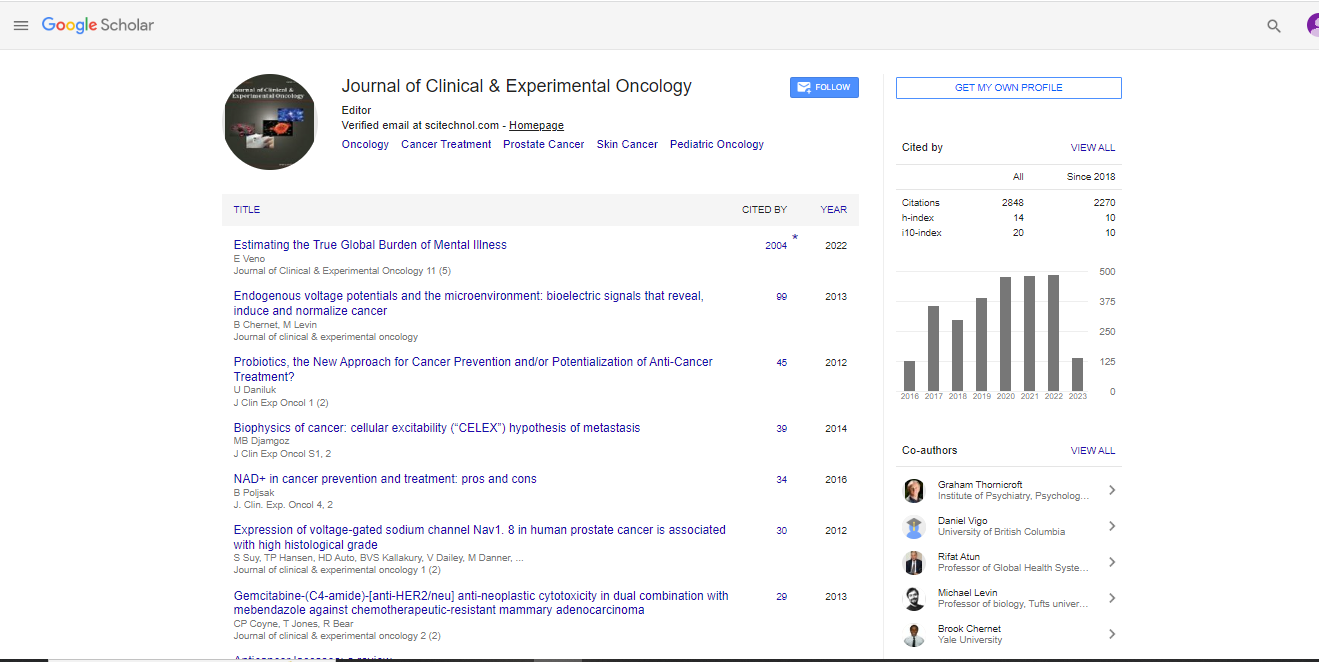Perspective, J Clin Exp Oncol Vol: 11 Issue: 4
Modified Glasgow Prognostic Score in Outcome Prediction
Anika Cohen*
Department of Surgery, University of Nairobi Medical School, Nairobi, Kenya
*Corresponding Author: Anika Cohen
Department of Surgery, University of Nairobi Medical School, Nairobi, Kenya
Email: anik@gmail.com
Received date: 22 March, 2022, Manuscript No. JCEOG-22-64496;
Editor assigned date: 29 March, 2022, PreQC No. JCEOG-22-64496 (PQ);
Reviewed date: 13 April, 2022, QC No JCEOG-22-64496;
Revised date: 21 April, 2022, Manuscript No. JCEOG-22-64496 (R);
Published date: 28 April, 2022, DOI: 10. 4172/2324.9110.1000298
Citation: Cohen A (2022) Modified Glasgow Prognostic Score in Outcome Prediction. J Clin Exp Oncol 11:4.
Keywords: Hodgkin's infection
Description
Information were gathered from 25 focuses and concentrate on bunches on an aggregate of 5141 patients treated with blend chemotherapy for cutting edge Hodgkin's infection, regardless of radiotherapy. The information incorporated the result and 19 segment and clinical qualities at conclusion. The end point was independence from movement of illness. Complete information were accessible for 1618 patients; the last Cox model was fitted to these information. Information from 2643 extra patients was utilized for fractional approval. The prognostic score we created might be valuable in planning clinical preliminaries for the treatment of cutting edge Hodgkin's illness and in going with individual restorative choices, yet a particular gathering of patients at extremely high gamble couldn't be distinguished based on regularly archived segment and clinical attributes. In nonrandomised studies, surmising causal impacts requires proper techniques for tending to puzzling inclination. In spite of the fact that it is normal to embrace affinity score investigation to this reason, prognostic score examination has as of late been proposed as an elective methodology.
While the two methodologies were initially acquainted with gauge causal impacts for twofold intercessions, the hypothesis of penchant score has since been reached out to the instance of general treatment systems. To be sure, numerous medicines are not relegated in a paired style and require a specific degree of dosing. Subsequently, specialists may frequently be keen on assessing treatment impacts across numerous openings. Apparently, the prognostic score examination has not been at this point summed up to this case. In this article, we portray the hypothesis of prognostic scores for causal derivation with general treatment systems. Our strategies can be applied to analyze numerous medicines utilizing nonrandomised information, a subject of incredible importance in contemporary assessments of clinical intercessions. We propose assessors for the typical treatment impacts in various populaces of interest, the legitimacy of which is evaluated through a progression of recreations. At last, we present an illustrative case in which we gauge the impact of the deferral to Aspirin organization on a composite result of death or reliance at a half year in stroke patients.
Meta-Analysis of Prognostic Factor
Obviously, it might shock no one that deriving causal impacts from nonrandomised information is no simple assignment. Principal, jumbling predisposition is probably going to happen in light of the fact that treatment openness ordinarily relies upon patient qualities and inclinations of parental figures. This suggests that significant endeavors are expected to deal with the presence of precise contrasts in covariate appropriations across treated people. A typical structure to address jumbling predisposition is to impersonate randomisation by affinity score examination, which expects to re-establish the equilibrium in the subjects' gauge covariate dispersions across the different treatment openings. The prognostic score examination is a connected strategy that looks to adjust the subjects' pattern visualization, instead of their covariates. Albeit both affinity and prognostic score investigations share comparable presumptions stable treatment unit worth and nonattendance of stowed away inclination, a significant benefit of the last option is that it loosens up the energy assumption,6 This supposition expects to have perceptions for all openings at each worth of the noticed confounders, which may be not really possible in that frame of mind of numerous openings. Further, on the grounds that the energy supposition of affinity score investigation is seldom assessed by and by, prognostic score examination shows up as an engaging choice to concentrate on causal impacts within the sight of different treatment openings.
Prognosis simply means foreseeing, predicting, or estimating the probability or risk of future conditions; familiar examples are weather and economic forecasts. In medicine, prognosis commonly relates to the probability or risk of an individual developing a particular state of health an outcome over a specific time, based on his or her clinical and non-clinical profile. Outcomes are often specific events, such as death or complications, but they may also be quantities, such as disease progression, changes in pain, or quality of life. In medical textbooks, however, prognosis commonly refers to the expected course of an illness. This terminology is too general and has limited utility in practice. Doctors do not predict the course of an illness but the course of an illness in a particular individual. Prognosis may be shaped by a patient’s age, sex, history, symptoms, signs, and other test results. Moreover, prognostication in medicine is not limited to those who are ill. Healthcare professionals, especially primary care doctors, regularly predict the future in healthy individuals—for example, using the Apgar score to determine the prognosis of newborns, cardiovascular risk profiles to predict heart disease in the general population, and prenatal testing to assess the risk that a pregnant woman will give birth to a baby with Down’s syndrome.
Use of Prognostic Models
Medical prognostication and prognostic models are used in various settings and for various reasons. The main reasons are to inform individuals about the future course of their illness or their risk of developing illness and to guide doctors and patients in joint decisions on further treatment, if any. For example, modifications of the Framingham cardiovascular risk score are widely used in primary care to determine the indication for cholesterol lowering and antihypertensive drugs. Examples from secondary care include use of the Nottingham prognostic index to estimate the long term risk of cancer recurrence or death in breast cancer patients, the acute physiology and chronic health evaluation APACHE score and simplified acute physiology score SAPS to predict hospital mortality in critically ill patients, and models for predicting postoperative nausea and vomiting.
Another reason for prognostication and use of prognostic models is to select relevant patients for therapeutic research. For example, researchers used a previously validated prognostic model to select women with an increased risk of developing cancer for a randomised trial of tamoxifen to prevent breast cancer. Another randomised trial on the efficacy of radiotherapy after breast conserving resection used a prognostic model to select patients with a low risk of cancer recurrence. Prognostic models are also used to compare differences in performance between hospitals. For example, the clinical risk index for babies (CRIB) was originally developed to compare performance and mortality among neonatal intensive care units. More recently Jarman et al developed a model to predict the hospital standardised mortality ratio to explain differences between English hospitals.
 Spanish
Spanish  Chinese
Chinese  Russian
Russian  German
German  French
French  Japanese
Japanese  Portuguese
Portuguese  Hindi
Hindi 



